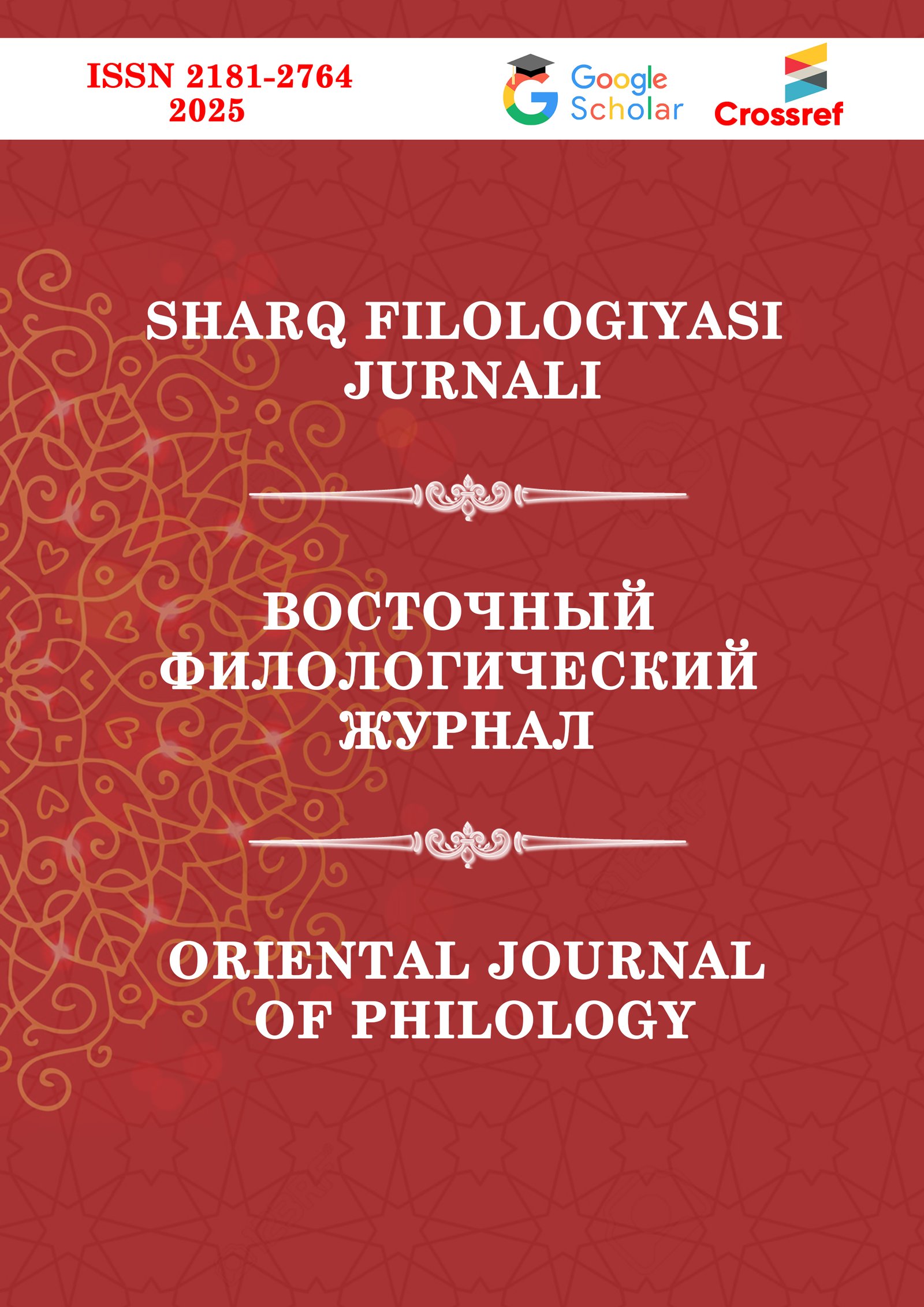 Articles
| Open Access |
DOI:
https://doi.org/10.37547/supsci-ojp-05-03-36
Articles
| Open Access |
DOI:
https://doi.org/10.37547/supsci-ojp-05-03-36
PROBLEMS OF RECREATING THE IZAFET COMBINATION IN UZBEK LANGUAGE (based on Arabic)
Jakhongir M. Abdupattakhov ,Abstract
The importance of translation in recent decades, with the development of artificial intelligence and its consistent introduction into the social, cultural, political and economic aspects of modern society, has exceeded all expectations and its universal role in maintaining the stability of international relations has increased significantly. Due to changing needs, a motley need for various types of translation is emerging. The leading role of linguists, translators and translation programs especially intensified during the spread of the Covid-19 virus and in the post pandemic period, its place rose to an incomparable first place. The task and role of social networks, Internet sites in the social life of societies have gone beyond such material barriers and boundaries that it is impossible to imagine all this without translators and linguists in the shadow of its non-repeatable and diverse culture and economic development, as well as in the constant flow of information news, as well as exchange programs in cultural and scientific achievements.
As mentioned above, the presentation of information, industry, artistic and socio-political news, Internet resources is unthinkable without translation activities.
This article will discuss some aspects about new approaches to the study and teaching of the lexical compound and the rules of the Arabic language.
In particular, the combined forms of izafet are considered, which are among the important rules of the Arabic language, as well as difficulties in reproducing the “izafet combination – “al-izafa al-shakliya”” in the Uzbek language. And as a measure to get rid of certain difficulties, it is proposed to study the so-called “al-izaf al-shakliya” in another topic, namely in the field of “definition”.
Keywords
agreed adjective, forms of izafet, al-izafa al-shakliya, al-izafa al-asliya, lexical structure, lexical combination.
References
Abdupattakhov, J.M. (2024) Composition of diplomatic correspondence (example Arab Republic of Egypt (2021). Diplomatik yozishmalarning tuzilishidagi xosliklar (Misr Arab Respublikasi misolida). The international scientific-practical conference on the topic “Foreign language in professional communication”. ISSN:2181-1784 4(25), Dec., 2024 UDK:801.82 200-208 p. (in Uzbek) https://doi.org/10.5281/zenogo.14413120
Abdupattaxov, J.M. Simultaneous translation in the Arabic-Uzbek combination: problems and solutions. Arab-o‘zbek kombinatsiyasida sinxron tarjima: muammolar va echimlar // Sharq Mash’ali scientific journal. Volume 4, 2021. ISSN 2010-9709 53-57 p. (in Uzbek)
Abdupattaxov, J.M. (2021) Arabic language. Part One. Arab tili.1-qism. – Toshent: TSUOS. – Number of permission 237-392 (31), May, 2021 152-156 p. (in Uzbek)
Abdupattaxov, J.M. (2021) Linguistic issues in comments on "Alfiya". “Alfiya”ga oid sharhlarda tilshunoslik masalalari. Scientific electronic magazine "21st century: issues of science and education". #3, 2021. ISSN: 2181-9874 SJIF 2021: 6.23 1-9 p. (in Uzbek) retrieved from www.sharqjurnali.uz
Abdupattaxov, J.M. Phonetic and written system of the Arabic language. (2024). Arab tilining fonetik va yozuv tizimi. – Toshkent: TSUOS. – Number of permission 25-UM (03), Fev., 2024. 81-82 p. (in Uzbek)
Al-Azhari, Zayniddin. (kh. 1310). Students' training in the art of parsing. Manuscript. Tamrin at-tullab fi sina’at al-i’rab. Egypt. – Al-Cairo. 156 p. (in Arabic)
Al-Jallad. A. (2020) Manual of the Historical Grammar of Arabic. Dalil al-nahv al-arabi al-tarikhi. 158 p. retrieved from https://web.archive.org/web/20210113063433/https://www.academia.edu/38100372/Al_Jallad_A_Manual_of_the_Historical_Grammar_of_Arabic
Al-Jarim, A; Amin, M. (1999). Clear Grammar. Second part. An-Nahv al-vadih. – Egypt, al-Qohira: Dar al-ma’arif. – 172 p. (in Arabic)
Bushuy, T., Safarov, Sh. (2007) Language construction: Analytical methods and methodology. Til qurilishi: Tahlil metodlari va metodologiyasi. – Namangan: ARM-7417. – 278 p. (in Uzbek)
Grande, B.M. (1998). Course of Arabic grammar in comparative-historical light. Kurs arabskoy grammatiki v sravnitel'no-istoricheskom osveshenii. – Moscow: RAN. – 592 p. (in Russian)
Ibn Hajib, J. (H1428/G2002). Sufficient with the comprehensive objectives of the sufficient. Kafiya ma’a-l-Vafiya bi-maqosid Al-Kafiya. – India: Maktabatu Hijaz Devband. – 216 p. (in Arabic)
Ibrohimov, N. et al. (2024). Arabic Grammar. Part One. Arab tili grammatikasi. 1- jild. – Tashkent: G‘afur G‘ulom. – 327 p. (in Uzbek)
Lexeme “Brain rot” retrieved from: https://corp.oup.com/news/brain-rot-named-oxford-word-of-the-year-2024/
Mirziyatov, Sh.M. (2017) Linguistics, lexicography, traditions and lexical-semantic interpretation of the Arabic-Turkish dictionary in the work "Mukaddatamat al-Adab". "Muqaddatamat-u-l-adab" asarida tilshunoslik, lug‘atshunoslik an’analari va arabiy-turkiy so‘zlikning leksik-semantik talqini. Dissertation written for obtaining the PhD degree in philological sciences. – Tashkent. 156 p. UDK: 809.27-1 M-54 (in Uzbek)
Saidov, A. Contribution of Ibn al-Muqaffa to the art of Islamic translation. Ibn al-Muqaffaning islom tarjima san’atiga qo‘shgan hissasi. // “Oriental Renaissance: Innovative, educational, natural and social sciences” Scientific journal. Volume 1, 2021. 332-336 p. (in Uzbek)
Saliyeva, M.K; Abdupattakhov, J.M. (2020) Peculiarities of journalism in modern Arab countries. Zamonaviy arab mamlakatlari jurnalistikasining o‘ziga xos xususiyatlari. Forum of Uzbekistan translators – 2020. Collection of scientific articles. Recommended for publication by decision of the Council of the TSUOS. volume 4(26), Nov., 2020. 309-313 p. (in Uzbek)
Article Statistics
Downloads
Copyright License
Copyright (c) 2025 Jakhongir M. Abdupattakhov

This work is licensed under a Creative Commons Attribution 4.0 International License.

